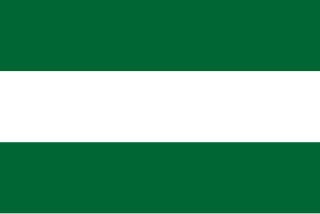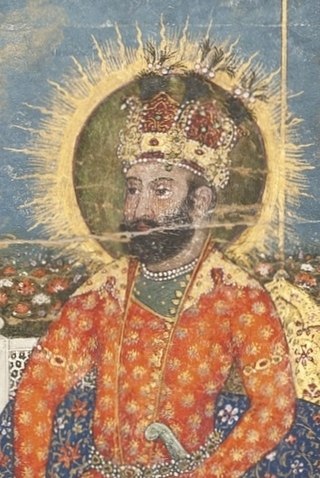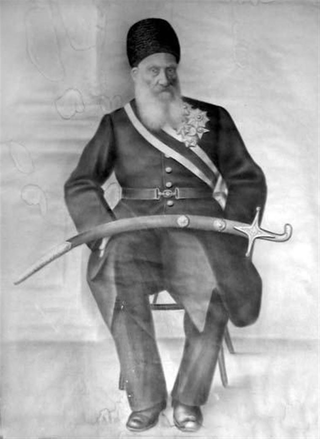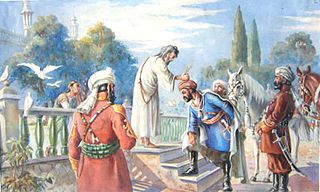
Ahmad Shāh Durrānī, also known as Ahmad Shāh Abdālī, was the founder of the Durrani Empire and is often regarded as the founder of modern Afghanistan.

The Durrani Empire, colloquially known as the Afghan Empire, or the Sadozai Kingdom, was an Afghan empire founded by the Durrani tribe of Pashtuns under Ahmad Shah Durrani in 1747, which spanned parts of Central Asia, the Iranian plateau, and the Indian subcontinent. At its peak, it ruled over present-day Afghanistan, much of Pakistan, parts of northeastern and southeastern Iran, eastern Turkmenistan, and northwestern India. Next to the Ottoman Empire, the Durrani Empire is considered to be among the most significant Islamic empires of the second half of the 18th century.

Zaman Shah Durrani, or Zaman Shah Abdali was the third King of the Durrani Empire from 1793 until 1801. An ethnic Pashtun of the Sadozai clan, Zaman Shah was the grandson of Ahmad Shah Durrani and the fifth son of Timur Shah Durrani.

Agha Mohammad Khan Qajar, also known by his regnal name of Agha Mohammad Shah, was the founder of the Qajar dynasty of Iran, ruling from 1789 to 1797 as Shah. Originally a chieftain of the Quwanlu branch of the Qajar tribe, Agha Mohammad Khan was enthroned as the king of Iran in 1789, but was not officially crowned until March 1796, having deposed Lotf Ali Khan of the Zand dynasty in 1794.

Shahrokh Mirza, better known by his dynastic title of Shahrokh Shah was the Afsharid king (shah) of the western part of Khorasan from 1748 to 1796, with a two-month interruption. A grandson of the Iranian conqueror Nader Shah, Shahrokh was the son of Reza Qoli Mirza Afshar and his Safavid wife Fatemeh Soltan Begom, who was the sister of Tahmasp II, the penultimate Safavid shah of Iran. Shahrokh's half-Safavid descent made him stand out amongst his Afsharid relatives, and was used to bolster the legitimacy of his grandfather. After the assassination of Nader Shah in 1747, his nephew Ali-qoli Khan, ascended the throne in Mashhad and had all of Nader Shah's descendants in fortress of Kalat massacred. Shahrokh was spared in case his Safavid lineage would come to use, and was instead kept in the fortress as a prisoner. While Adel Shah was battling his rebellious younger brother Ebrahim Mirza, a party of Turkic, Kurdish, and Arab tribal leaders took advantage of his absence and installed Shahrokh on the throne. Both Adel Shah and Ebrahim were eventually defeated and killed, but Shahrokh was not long afterwards overthrown by a party of dissident tribal leaders, who installed the Safavid pretender Mir Sayyed Mohammad on the throne. Shahrokh was soon blinded at the instigation of Mir Alam Khan Khuzayma and other leading nobles, much against Suleiman II's will.

Alakozai is a Pashtun tribe in Afghanistan. They are one of the four tribes of the Zirak tribal confederacy of Durrani Pashtuns.

Eshaq Khan Qaraei-Torbati, was one of the wealthiest and most powerful chieftains in Khorasan during the reigns of Agha Mohammad Khan and Fath Ali Shah. He was fluent in Persian and Arabic.

Kamran Mirza Durrani was the last Durrani ruler of Herat from 1826 to 1842. He was the son and successor of Mahmud Shah Durrani.
The Battle of Kafir Qala was fought in June 1818 between Iran and the Durrani Empire.

Timur Shah Durrani, also known as Timur Shah Abdali or Taimur Shah Abdali was the second ruler of the Afghan Durrani Empire, from November 1772 until his death in 1793. An ethnic Pashtun, he was the second eldest son of Ahmad Shah Durrani.

The conquest of Khorasan by Safavid loyalist forces against separatists in Khorasan was Nader Shah's first major military campaign which he waged on behalf of the new Safavid pretender to the throne, Tahmasp II. It would propel him into the centre of the political landscape of war-torn early eighteenth-century Persia.

After Nader Shah was assassinated in 1747, his nephew Ali Qoli seized the throne and proclaimed himself Adil Shah. He ordered the execution of all Nader's sons and grandsons, with the exception of the 13-year-old Shahrokh, the son of Reza Qoli.

The Khanate of Nishapur, also known as the Qara Bayat Amirdom, was a semi-independent state ruled by the Bayat tribe that existed in Khorasan from 1747 to 1800, whose capital was in the city of Nishapur.

The Guarded Domains of Iran, commonly referred to as Afsharid Iran or the Afsharid Empire, was an Iranian empire established by the Turkoman Afshar tribe in Iran's north-eastern province of Khorasan, establishing the Afsharid dynasty that would rule over Iran during the mid-eighteenth century. The dynasty's founder, Nader Shah, was a successful military commander who deposed the last member of the Safavid dynasty in 1736, and proclaimed himself Shah.
The Revolt of Hasan Khan Salar(Persian: شورش حسن خان سالار) was a revolt that occurred in Khorasan from 1846 to 1850. It began as a result of the power struggle in the Qajar court. One of the factions manifested itself in Khorasan by Hasan Khan Salar. Salar's revolt sought to promote Bahman Mirza and his claim to power.

The Principality of Herat, the Emirate of Herat, the Herat Khanate or simply Herat was a state in Afghanistan from 1793 to 1863, and one of the three main khanates that existed in 19th century Afghanistan after the breakup of the Durrani Empire.

The Second Herat War was the invasion of the surrounding realm of Herat and the successful siege of its citadel by the Qajar army led by Hesam o-Saltaneh, Morad Mirza. The 1856 siege was part of the concerted Qajar effort to compensate the recent territorial losses in the Russo-Persian Wars of 1804–1813 and 1826–1828 by reconquering western Afghanistan, which had historically been a part of Persia's domain. The conflict was also a part of the broader Great Game between the British Empire and the Russian Empire.
Mir Muhammad Nasir Khan I Ahmadzai was the Khan of Kalat between 1749 and 1794. Considered greatest of the Khans of Kalat, his reign was marked by maximum expansion of the state as well as political consolidation of the Khanate of Kalat. He was known as Nasir Khan Noori among his subjects.

The Tarikh-i Ahmad Shahi is a chronicle, written in Persian, by Mahmud al-Husayni. He had been hired by Ahmad Shah Durrani to mark the achievements of his rule. The Tarikh-i Ahmad Shahi was written during and encompassed the entire reign of Ahmad Shah. It was more than merely an accessible glimpse into Afsharid historiography, it illustrated Persian historiography through the use of dramaturgy that combined prose, rhymed prose, and poetry.
The siege of Herat took place in late 1833 at Herat between Qajar Iran and the city's local Durrani ruler, Kamran Shah Durrani.















